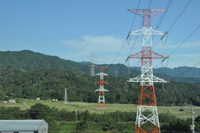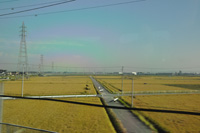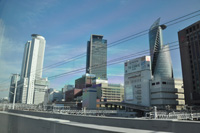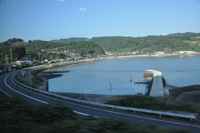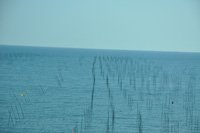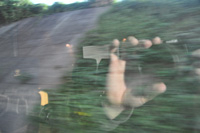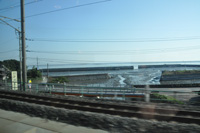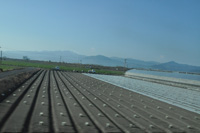 The Shinkansen, also known as the bullet train, is a network of high-speed railway lines in Japan operated by four Japan Railways Group companies. Starting with the 210 km/h (130 mph) Tōkaidō Shinkansen in 1964, the now 2,459 km (1,528 mi) long network has expanded to link most major cities on the islands of Honshū and Kyūshū at speeds up to 300 km/h (186 mph). Test runs have reached 443 km/h (275 mph) for conventional rail in 1996, and up to a world record 581 km/h (361 mph) for maglev trainsets in 2003. Shinkansen literally means new trunk line, referring to the tracks, but the name is widely used inside and outside Japan to refer to the trains as well as the system as a whole. The name Superexpress, initially used for Hikari trains, was retired in 1972 but is still used in English-language announcements and signage. The Tōkaidō Shinkansen is the world's busiest high-speed rail line. Carrying 151 million passengers a year (March 2008), it has transported more passengers (over 6 billion) than any other high speed line in the world. Between Tokyo and Osaka, the two
The Shinkansen, also known as the bullet train, is a network of high-speed railway lines in Japan operated by four Japan Railways Group companies. Starting with the 210 km/h (130 mph) Tōkaidō Shinkansen in 1964, the now 2,459 km (1,528 mi) long network has expanded to link most major cities on the islands of Honshū and Kyūshū at speeds up to 300 km/h (186 mph). Test runs have reached 443 km/h (275 mph) for conventional rail in 1996, and up to a world record 581 km/h (361 mph) for maglev trainsets in 2003. Shinkansen literally means new trunk line, referring to the tracks, but the name is widely used inside and outside Japan to refer to the trains as well as the system as a whole. The name Superexpress, initially used for Hikari trains, was retired in 1972 but is still used in English-language announcements and signage. The Tōkaidō Shinkansen is the world's busiest high-speed rail line. Carrying 151 million passengers a year (March 2008), it has transported more passengers (over 6 billion) than any other high speed line in the world. Between Tokyo and Osaka, the two largest metropolises in Japan, up to ten trains per hour with 16 cars each (1,300 seats capacity) run in each direction with a minimum of 3 minutes between trains. Though largely a long-distance transport system, the Shinkansen also serves commuters who travel to work in metropolitan areas from outlying cities.
largest metropolises in Japan, up to ten trains per hour with 16 cars each (1,300 seats capacity) run in each direction with a minimum of 3 minutes between trains. Though largely a long-distance transport system, the Shinkansen also serves commuters who travel to work in metropolitan areas from outlying cities.
I thought my first attempt at catching the Shinkansen was going to be an ordeal after going the wrong way on two subways last night, but it took me about thirty minutes to get from the ryokan to Tokyo Station this morning. I woke up after two hours last night still exhausted. Fourteen hours difference is throwing me for a loop, but I'm going to arrive in Nagasaki early as a result of getting out at 5am this morning. I have five days of retreat to recover and get acclimated to the time.
And off we go. The train schedules are precise to the second. I leave Tokyo on a rainy morning. It is about 74º and muggy. I definitely dressed for the mountains, but the heat doesn't bother me much anymore. I might not say that as I travel south. I'm getting my first daytime look at the massive Tokyo skyline. There are skyscrapers everywhere and the Times-Squareish billboards I referred to in an earlier post. Now we're really moving. I'm in a southern suburb, but this is Tokyo and all the residences are several stories and packed together.
 The sky might be clearing: I'm seeing some mountains in the distance. I really hope I get to see Fuji today. Andthere it is. Not a great first picture, but it is emerging. Out here the houses look a bit like neighborhoods in the hills of Pittsburgh. We are flying! Lots of tunnels. Now the sky is clear.
The sky might be clearing: I'm seeing some mountains in the distance. I really hope I get to see Fuji today. Andthere it is. Not a great first picture, but it is emerging. Out here the houses look a bit like neighborhoods in the hills of Pittsburgh. We are flying! Lots of tunnels. Now the sky is clear.
After changing trains in Osaka I'm off again on not as nice of a train, but still a bullet heading for Hakata where I catch a local to Nagasaki. I left Tokyo at 6:30am local time and will be at the retreat center by 4pm, on the other end of the country. It's a beautiful day in Japan. Farmers are harvesting rice and the leaves have not begun to change. It's feeling more like a late August day.
 I encountered concern from some of my Japanese hosts, particularly in more remote areas, about getting lost in the train system. There were offers of assistance, almost to the point of being overbearing. Where some of the monks, in particular, expressed reservations about my navigating trains by myself I never had that worry, even when I got on a couple trains in the wrong direction. If I had to use the Kanji or Kana letters to figurethings out it would have taken longer and probably been frustrating, but even if only town names were in Roman letters I didn't have much trouble. I had an easier time getting around Tokyo than I do in Manhattan. I thought Italy was easy to get around, but Japan is light years easier. I felt ready, and this confidence made all the difference.
I encountered concern from some of my Japanese hosts, particularly in more remote areas, about getting lost in the train system. There were offers of assistance, almost to the point of being overbearing. Where some of the monks, in particular, expressed reservations about my navigating trains by myself I never had that worry, even when I got on a couple trains in the wrong direction. If I had to use the Kanji or Kana letters to figurethings out it would have taken longer and probably been frustrating, but even if only town names were in Roman letters I didn't have much trouble. I had an easier time getting around Tokyo than I do in Manhattan. I thought Italy was easy to get around, but Japan is light years easier. I felt ready, and this confidence made all the difference.
I'm thinking about the virtues of mobility and would like to find a way to begin a discussion of the pros and cons of mobility in society. It seems like people run from themselves most of the time. In thinking about the interpretation of dreams I'm always puzzled by the people who say they never dream. When I don't dream I think there's something wrong; specifically something that I don't want to face. If I'm not dreaming then there is often some obstacle to allowing material to surface. I love being on the move and there is not a single hassle in taking trains here, which makes the experience of travel that much more enjoyable. I know I can load my schedule to such a degree that I don't have time to think. In these periods there's often a dream or two that, upon examination, wakes me out of my inattention. There are other moments, I hope infrequent, when I am making some choice to repress something to keep an insight from surfacing. It's common to be so busy or on the move that we don't pay attention to what needs to surface.
